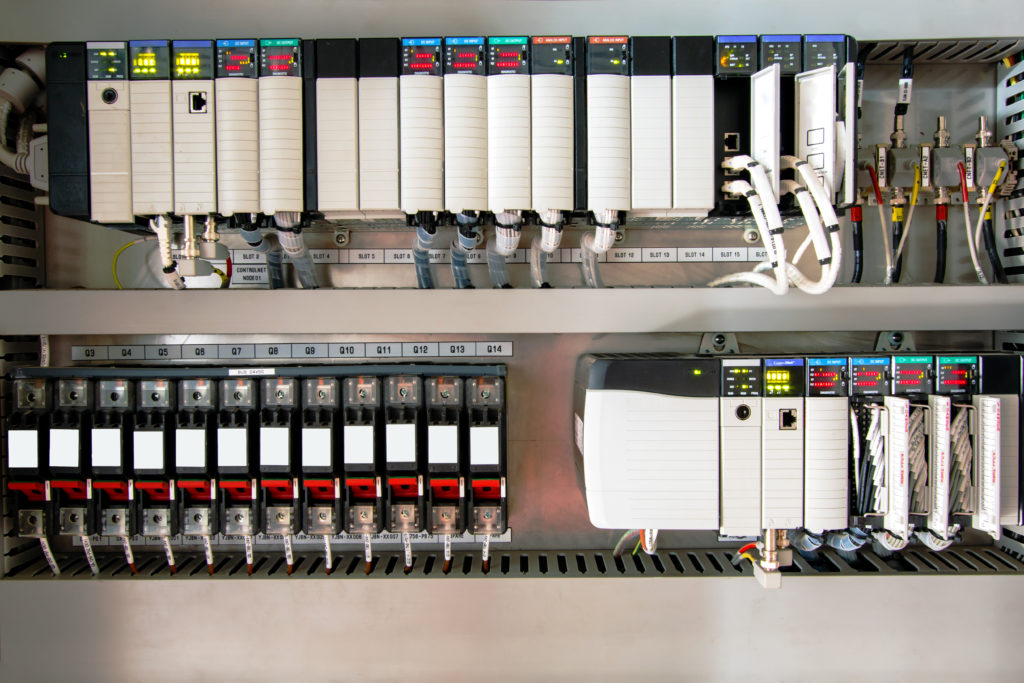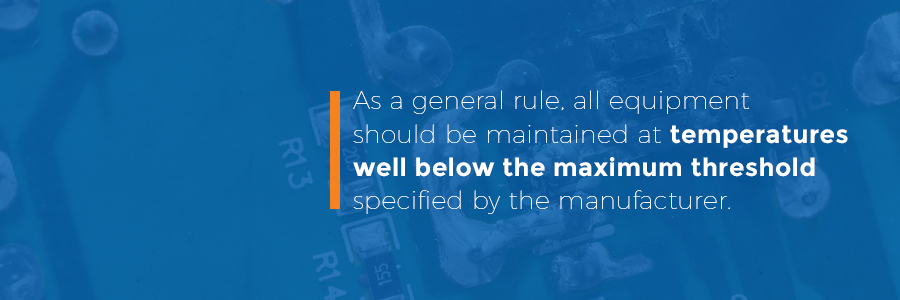Common Causes of Programmable Logic Controller Failure


Quick Links: Input/Output Modules and Field Devices | Ground Integrity | Power Supply Failure | Electrical Noise Interference | Loss of Network Communication | Heat | Conflict With the Outer Environment | Corrupted Memory | Managing the Risks
Reasons Why PLC Control Systems Fail
At industrial facilities, vast numbers of electronically operated machines are programmed to move in various directions. None of this would be possible without a programmable logic controller (PLC), which translates commands for machines to understand.
On machines, a user will push a button to activate a particular command. However, the machine itself has no way of understanding this without a programmable code. Therefore, a code must cause the machine to act. The PLC code lives in a central processing unit that acts as the go-between. The user pushes a button, the PLC translates this information into a command the machine can understand and the command takes effect.
Since their development in the late 1960s, PLCs have grown more complex. Today, the code is programmed for a variety of complex tasks. As such, PLCs run nonstop to translate continual strings of command for corresponding machinery. Despite these complexities, PLCs can also have problems.
Common reasons why PLC control systems fail include module failure, power outages and bad network connections. PLC failure issues can also stem from overheating, moisture and electromagnetic interference. To combat PLC control systems issues, factory engineers must inspect their systems to ensure these problems do not spiral out of hand.
Granted, a PLC is designed to operate in harsh environments. That said, even the most complex commanding code can run into problems if it is subject to blackouts, brownouts or anything that could be physically harmful to circuitry. Therefore, it is crucial to know exactly what will cause PLC failure and how to stop and prevent this problem.
Input/Output Modules and Field Devices
In four out of five cases where a PLC fails, the problem comes down to one of the following three factors:
- module failure of the input/output (I/O)
- problems with a field device
- problems with the power supply
When a problem with one of these components occurs, the issue becomes apparent with disruptions to the process at hand. In some cases, the process stops abruptly.
Each of these problems denies the PLC system the signal it needs to enact a sequence. To remedy such problems, an engineer will examine the system software to determine the root of the problem, which is typically due to a certain I/O point.
Once the engineer pinpoints the afflicted I/O module, they can trace the extent of the problem from one end to the other. Various issues could be at hand in this situation, including the following:
- an error in the PLC configuration
- a loose terminal block
- a failed VCD supply
- problems with the wires
- a tripped circuit breaker
In some cases, the I/O module might be due for a replacement. For systems that have been intact for many years, this can be difficult. A newer module might be incompatible with the older components that comprise the system in question.

When one or more inputs act irregularly or fail outright, it usually means an error is present with either the PLC or the power source. The first step is to see whether the problem is rooted in the I/O module. The next step is to see whether the wires or power source have caused the problem at hand. If neither of those components is the source of the failure, the next step is to inspect the field devices.
The parts of the system that are physically separate from the I/O module should have their configurations checked for errors. With any field device, a problem could also be the result of damage to the circuitry, which is sometimes the result of moisture exposure.
Ground Integrity
For a PLC and its maintenance crew to remain safe, correct grounding is essential. Ground integrity also serves as a sound barrier that protects against electrical white noise. Each time an inspector looks at a PLC, they should examine the ground wiring to determine if any problems are present.
For example, a ground wire that becomes partially damaged by the elements is liable to have restricted capacity, even if it still works to some degree. If the grounding of the wire comes loose, that too would defeat the purpose. Wires must be fully intact and grounded to send electricity to a PLC system.
The problems to look for with ground wiring would include damage to the wires and weak connections. As the engineer performs these inspections, they can test the wiring with a multimeter. Is the PLC ground terminal resistant to the connecting point of the equipment? Knowing this would help identify the cause of the issue.
Power Supply Failure
For a PLC to enact programming code between an input and output, the PLC must have a steady, uninterrupted stream of power. When a power source halts, the problem could be down to one of several causes. Outages due to local or regional blackouts notwithstanding, the most common sources of power failure include grid failure, loose connections and worn cables.
To avoid the possibility of power failure, the majority of today’s industrial facilities have backup power sources. In the event of a mainframe blackout, the secondary power source keeps the most vital functions of the facility running nonstop, or at least long enough to be shut down properly. Some facilities use what is called an uninterrupted power supply, which functions as a redundant source of power.
However, not all factories find this process essential. Consequently, these facilities could experience major system damage if a main-source outage does occur. Damage is due to the shocks system components receive when brownouts or blackouts hit. A power surge could fry various system components in the event of a power surge, while others might not work as effectively as before. Moreover, process data can be lost during a blackout if operators couldn’t save the data in advance of the outage.

The worst thing about power outages at facilities that don’t employ backup is the loss potential. In many cases, the outage will be minor and only last for a half-hour or less, yet the damage will be permanent. With backup power sources, facilities can easily overcome such incidents with little or no loss to a PLC system.
On some PLCs, batteries are installed for prolonged power when a blackout hits. This way, data can be saved and the PLC can properly be shut down for the duration of the outage. Once power resumes, the PLC can be restarted properly.
Electrical Noise Interference
Foreign signal interference due to electrical noise can greatly impact the performance of a PLC. The most common cause of electrical noise is electromagnetic interference, which typically occurs when a large motor is activated or when lightning hits nearby. Another cause of electrical noise is radio frequency interference, which can be the result of nearby antennas and handheld transmitters.
The damage caused by electrical noise can range from PLC hiccups to outright failure. As such, it is vital facilities contain the possibility of such interference as much as possible. Failure to do so could result in lengthy downtime and costly damage.
On an industrial premise, handheld devices that could cause interference should be prohibited on the floor. Furthermore, any machinery on the premises that could be problematic in this regard should be segregated from the PLC. If in doubt, have a service engineer come and help you discover the most effective ways to barricade or section off potentially interfering components.
Loss of Network Communication
The majority of PLC control systems must have contact with surrounding equipment to function properly. Such equipment would include peripherals and human-machine interfaces. These different components connect to one another via ethernet cables, which pass commands from one point to another.
If a connection between two devices fails for whatever reason, the devices cannot carry out their intended functions as programmed. Consequently, communication loss will typically result in downtime at an industrial facility. When system diagnostics are performed, indicators will reveal the root of the disconnect. Communication failure is sometimes rooted in a central processing unit.
To safeguard systems from such occurrences, engineers must regularly inspect the connections between different system parts. While performing these inspections, technicians should check the physical infrastructure of a system network at each point to ensure prompts can be activated and terminated as commanded.
When additional devices are added to the system, further inspections must be performed to ensure the new connections are solid and that older connections remain undisrupted. To ensure operations remain safe, firmware needs to be installed with each new device, as well as patches to safeguard against security holes.
Heat
One of the biggest dangers for electronic components is excess heat. A PLC system surrounded by heat-emitting equipment could be at risk of failure if not properly safeguarded. As a general rule, all equipment should be maintained at temperatures well below the maximum threshold specified by the manufacturer. Otherwise, the PLC and/or peripheral part could overheat and fail to work properly, if at all.

Humid environments also generate moisture, which also can have a damaging effect on a PLC. If condensation goes undetected and accumulates within a PLC, the controller might suddenly stop working. Consequently, a facility could wind up temporarily shut down pending costly repairs due to heat-related problems.
At facilities with HVAC systems, the cooling setting should be set to a level that will keep the area around the PLC at a relatively low temperature. Anything that generates heat at sufficient levels should be kept at a safe distance from the PLC. As long as the PLC can operate well within the temperature levels recommended by the manufacturers, your PLC shouldn’t be at risk of heat-related performance problems.
Conflict With the Outer Environment
A PLC can malfunction or fail when the internal status of code is incompatible with something that occurs on the outside. Maybe a part has been changed along one of the attached peripherals? Or maybe an update has taken place, and the code could not comprehend these changes? In any case, a PLC can only command what it is programmed to understand.
On some systems, an input device will be attached without sufficient testing for compatibility. Consequently, the PLC will not be able to comprehend the commands it receives. In turn, the PLC will not be able to put those commands into action. Therefore, any changes to a system should be fully tested to ensure everything runs according to plan.
Corrupted Memory
The memory of a PLC can become corrupted by external factors such as frequency interference and disruptions of power. For example, when a brownout or blackout occurs, the shock could render the code unreadable by the central processing unit. Likewise, a PLC that is not able to shut down properly due to a sudden loss of power might not read properly once you start it back up.

To prevent memory loss in your PLC, copy all data to a redundant storage unit. Store the redundant copies away from sources of electromagnetic interference, radio frequency interference or any source of heat.
Managing the Risks
In order to reduce the possibility of PLC problems, facility engineers must follow procedural steps to ensure all parts are properly connected at all ends. Furthermore, the operating environment of a PLC system should be well maintained to ensure no electric noise, moisture or excess heat are present.
Some factories have failed over the years to enact sufficient maintenance procedures. Consequently, these facilities have experienced an undue share of system and parts failure, the likes of which prove costly. One of the biggest possible oversights is the failure to detect overheating issues, which can have a destructive effect on any piece of equipment that takes commands from a PLC. Moreover, heat and the resulting moisture can cause controller failure.
The problem with electrical noise is also serious, as it can disrupt the command code of a PLC. When a system is prompted to enact a certain command, the PLC might not be able to process the commands if signal interference occurs. Therefore, facilities must enact strict measures to ensure nothing that could cause electromagnetic or radio interference is anywhere within range of a PLC.
Most of all, it is crucial to ensure a spare power supply backs a PLC system at all times. This way, if the main power source goes down for any length of time, factories can operate at full or at least necessary capacity. Furthermore, facilities must regularly inspect the wire integrity, grounding and ethernet connections at all applicable points along a PLC system.
In some cases, however, even the most well-maintained electronic components fail and need to be restored. Whether you have a servo motor or a piece of hydraulic equipment that has failed, you could have it back in working condition if you know where to turn. At Global Electronic Services, we repair and service a vast range of industrial electronics. Contact GES for repair work today.
Be sure to visit us online at gesrepair.com or call us at 1-877-249-1701 to learn more about our services. We’re proud to offer Surplus, Complete Repair and Maintenance on all types of Industrial Electronics, Servo Motors, AC and DC Motors, Hydraulics and Pneumatics. Please subscribe to our YouTube page and Like Us on Facebook! Thank you!
